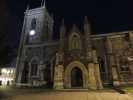Discover the...
Marlow Community Choir at Borlase
Giuseppe Fortunino Francesco Verdi (1813-1901)
Messa de Requiem (1874)
Giuseppe Verdi, born the son of a humble village grocer died as one of the most celebrated opera composers of all time.
He is known as an opera composer, writing very few non-operatic works, but of these, the one that stand out is the Requiem.
Much of Verdi’s operatic skill comes to the fore in the Requiem although the style and the texture of Verdi’s Requiem are very different.
Verdi was indeed a master of dramatic art with a particular devotion to Shakespeare and he took pride in faithfully capturing the theatrical
essence for his operas.
Verdi was an agnostic, but in the Requiem he captures the drama of the Latin text and magnifies it through music.
How did the Requiem come to be written?
It was composed for Alessandro Manzoni (1785-1873) regarded by Italians as the central figure of Italian culture and literature of the 19th
century.
Earlier, Verdi conceived a scheme to honour Gioachino Rossini (1792-1868) by collaborating with twelve composers of Italian opera on a
Requiem to celebrate Rossini’s anniversary.
After Rossini’s death in 1868, Verdi proposed that a Requiem be written in his honour.
The composers, including Verdi, would each contribute a movement.
Verdi’s contribution was to be the concluding Libera Me, but cooperation for the scheme failed to match the initial enthusiasm for the idea,
so the plan was abandoned.
The piece fell into oblivion until 1988 when Helmuth Rilling premiered the complete Messa per Rossini in Stuttgart, Germany.
After Manzoni’s death, Verdi seized the opportunity to use the Libera Me as part of a new Requiem that would be entirely his own work.
The Messa di Requiem, originally known as the Manzoni Requiem, is a musical setting of the Roman Catholic funeral mass for four soloists,
double choir and orchestra.
It includes a revised version of the Libera Me, originally written for the Rossini Requiem.
The Messa di Requiem was first performed on 22nd May 1874, the first anniversary of Manzoni’s death, in San Marco (St. Mark’s Church),
Milan, and was conducted by Verdi himself.
The Archbishop gave special permission for the inclusion of female choristers, who were dressed in full-length black dresses and mourning
veils and were hidden behind a screen.
The successful performance was somewhat restrained by the prohibition of applause.
In contrast, a second performance, three days later, at La Scala Opera House, again conducted by Verdi, was received by a full house
with tumultuous enthusiasm.
The Requiem became an overnight sensation and the British premiere took place in May 1875 at the new Royal Albert Hall,
conducted once again by Verdi, with a chorus of over 1,000 and an orchestra of 140.
As one journalist reviewed it, ‘the most beautiful music for the Church that has been produced since Mozart’s Requiem.’
The Requiem is divided into seven segments, or which the Dies Irae (including the Tuba Mirum through to the Lacrymosa)
comprises about half of the total length of the piece.
The orchestra is fairly standard for the time, the main difference being an extra pair of bassoons, lending a darker tone throughout
much of the music, and off-stage trumpets used for the Tuba Mirum.
Few choral works have captured the public imagination quite like Verdi’s Requiem.
Verdi’s direct style, his soaring, lyrical melodies which lie perfectly for the human voice,
the orchestration and the work’s dramatic and emotional intensity, make the Requiem one of the great icons of Western music.






